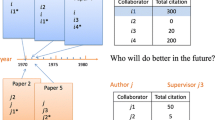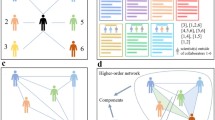Abstract
This paper concentrates on the connections in the collaboration network and aims to explore what kinds of connections improve the joint output of the two nodes in connection, using the collaboration data of top institutions in the field of Information Science and Library Science for the period 2007–2016. More intensive connections are found between top institutions, and most institutions are connected into the largest component. The effect of international connection on performance is compared between US and non-US institutions. The homophily of centrality, tie strength and h-index measured as assortativity coefficient is described to show how institutions of similar properties tend to connect with each other in the graph. Furtherly, a negative binomial regression model is employed to investigate the relationship between the homogenous connections and the citation counts received by the connections. Characteristics of connections that contribute to good performance are then obtained.
Similar content being viewed by others
References
Abbasi, A. (2016). A longitudinal analysis of link formation on collaboration networks. Journal of Informetrics, 10(3), 685–692.
Abbasi, A., Altmann, J., & Hossain, L. (2011). Identifying the effects of co-authorship networks on the performance of scholars: A correlation and regression analysis of performance measures and social network analysis measures. Journal of Informetrics, 5(4), 594–607.
Abbasi, A., Hossain, L., & Leydesdorff, L. (2012). Betweenness centrality as a driver of preferential attachment in the evolution of research collaboration networks. Journal of Informetrics, 6(3), 403–412.
Badar, K., Frantz, T. L., & Jabeen, M. (2016). Research performance and degree centrality in co-authorship networks: The moderating role of homophily. Aslib Journal of Information Management, 68(6), 756–771.
Badar, K., Hite, J. M., & Ashraf, N. (2015). Knowledge network centrality, formal rank and research performance: Evidence for curvilinear and interaction effects. Scientometrics, 105(3), 1553–1576.
Barabasi, A. L., & Albert, R. (1999). Emergence of scaling in random networks. Science, 286(5439), 509–512.
Bonacich, P. (1987). Power and centrality: A family of measures. American Journal of Sociology, 92(5), 1170–1182.
Bordons, M., Aparicio, J., González-Albo, B., & Díaz-Faes, A. A. (2015). The relationship between the research performance of scientists and their position in co-authorship networks in three fields. Journal of Informetrics, 9(1), 135–144.
Borgatti, S. P., Mehra, A., Brass, D. J., & Labianca, G. (2009). Network analysis in the social sciences. Science, 323(5916), 892–895.
Dehdarirad, T., & Nasini, S. (2017). Research impact in co-authorship networks: A two-mode analysis. Journal of Informetrics, 11(2), 371–388.
Ebadi, A., & Schiffauerova, A. (2015). How to become an important player in scientific collaboration networks? Journal of Informetrics, 9(4), 809–825.
Freeman, L. C. (1979). Centrality in social networks conceptual clarification. Social Networks, 1(3), 215–239.
Frenken, K., Hardeman, S., & Hoekman, J. (2009). Spatial scientometrics: Towards a cumulative research program. Journal of Informetrics, 3(3), 222–232.
Glänzel, W., & Schubert, A. (2001). Double effort = Double impact? A critical view at international co-authorship in chemistry. Scientometrics, 50(2), 199–214.
Han, P., Shi, J., Li, X., Wang, D., Shen, S., & Su, X. (2014). International collaboration in LIS: Global trends and networks at the country and institution level. Scientometrics, 98(1), 53–72.
Hâncean, M. G., & Perc, M. (2016). Homophily in coauthorship networks of East European sociologists. Scientific Reports, 6, 36152.
He, B., Ding, Y., Tang, J., Reguramalingam, V., & Bollen, J. (2013). Mining diversity subgraph in multidisciplinary scientific collaboration networks: A meso perspective. Journal of Informetrics, 7(1), 117–128.
Hirsch, J. E. (2005). An index to quantify an individual’s scientific research output. Proceedings of the National Academy of Sciences of the United States of America, 102(46), 16569–16572.
Hoekman, J., Frenken, K., & Tijssen, R. J. W. (2010). Research collaboration at a distance: Changing spatial patterns of scientific collaboration within Europe. Research Policy, 39(5), 662–673.
Katz, J. S., & Martin, B. R. (1997). What is research collaboration? Research Policy, 26(1), 1–18.
Leeuwen, T. N. V. (2009). Strength and weakness of national science systems: A bibliometric analysis through cooperation patterns. Scientometrics, 79(2), 389–408.
Li, E. Y., Liao, C. H., & Yen, H. R. (2013). Co-authorship networks and research impact: A social capital perspective. Research Policy, 42(9), 1515–1530.
Lungeanu, A., & Contractor, N. S. (2015). The effects of diversity and network ties on innovations: The emergence of a new scientific field. American Behavioral Scientist, 59(5), 548–564.
Mcpherson, M., Smithlovin, L., & Cook, J. M. (2001). Birds of a feather: Homophily in social networks. Annual Review of Sociology, 27(1), 415–444.
Newman, M. E. J. (2001). Scientific collaboration networks. I. Network construction and fundamental results. Physical Review E Statistical Nonlinear & Soft Matter Physics, 64(2), 016131.
Newman, M. E. J. (2002). Mixing patterns in networks. Physical Review E: Statistical, Nonlinear, and Soft Matter Physics, 67(2), 026126.
Nguyen, T. V., Ho-Le, T. P., & Le, U. V. (2017). International collaboration in scientific research in Vietnam: An analysis of patterns and impact. Scientometrics, 110(2), 1–17.
Nomaler, Ö., Frenken, K., & Heimeriks, G. (2013). Do more distant collaborations have more citation impact? Journal of Informetrics, 7(4), 966–971.
Pepe, A., & Rodriguez, M. A. (2010). Collaboration in sensor network research: An in-depth longitudinal analysis of assortative mixing patterns. Scientometrics, 84(3), 687–701.
Persson, O. (2010). Are highly cited papers more international? Scientometrics, 83(2), 397–401.
Ribeiro, L. C., Rapini, M. S., Silva, L. A., & Albuquerque, E. M. (2018). Growth patterns of the network of international collaboration in science. Scientometrics, 114(3), 159–179.
Sabidussi, G. (1966). The centrality index of a graph. Psychometrika, 31(4), 581–603.
Suárez-Balseiro, C., García-Zorita, C., & Sanz-Casado, E. (2009). Multi-authorship and its impact on the visibility of research from Puerto Rico. Information Processing and Management, 45(4), 469–476.
Ubfal, D., & Maffioli, A. (2011). The impact of funding on research collaboration: Evidence from a developing country. Research Policy, 40(9), 1269–1279.
Verleysen, F. T., & Weeren, A. (2016). Clustering by publication patterns of senior authors in the social sciences and humanities. Journal of Informetrics, 10(1), 254–272.
Wagner, C. S., Whetsell, T. A., & Leydesdorff, L. (2017). Growth of international collaboration in science: Revisiting six specialties. Scientometrics, 110(3), 1633–1652.
Wang, J. (2016). Knowledge creation in collaboration networks: Effects of tie configuration. Research Policy, 45(1), 68–80.
Whittington, K. B. (2018). A tie is a tie? Gender and network positioning in life science inventor collaboration. Research Policy, 47(2), 511–526.
Wuchty, S., Jones, B. F., & Uzzi, B. (2007). The increasing dominance of teams in production of knowledge. Science, 316(5827), 1036–1039.
Author information
Authors and Affiliations
Corresponding author
Rights and permissions
About this article
Cite this article
Tu, J. What connections lead to good scientific performance?. Scientometrics 118, 587–604 (2019). https://doi.org/10.1007/s11192-018-02997-7
Received:
Published:
Issue Date:
DOI: https://doi.org/10.1007/s11192-018-02997-7




